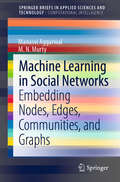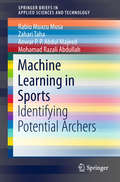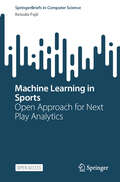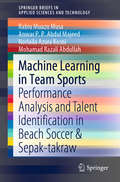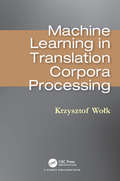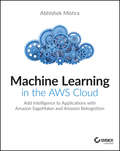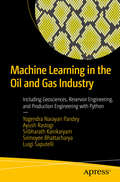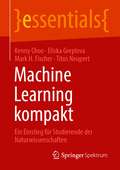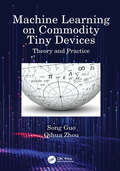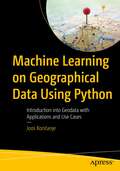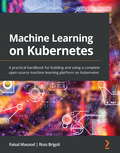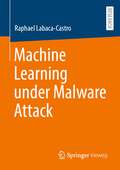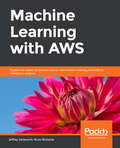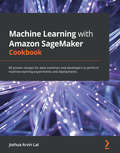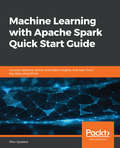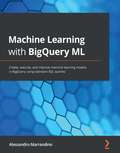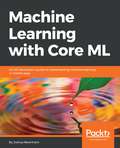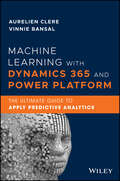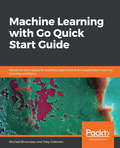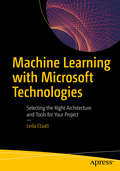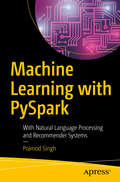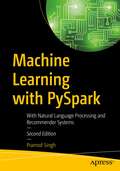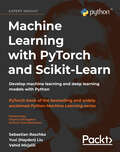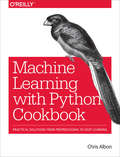- Table View
- List View
Machine Learning in Social Networks: Embedding Nodes, Edges, Communities, and Graphs (SpringerBriefs in Applied Sciences and Technology)
by M.N. Murty Manasvi AggarwalThis book deals with network representation learning. It deals with embedding nodes, edges, subgraphs and graphs. There is a growing interest in understanding complex systems in different domains including health, education, agriculture and transportation. Such complex systems are analyzed by modeling, using networks that are aptly called complex networks. Networks are becoming ubiquitous as they can represent many real-world relational data, for instance, information networks, molecular structures, telecommunication networks and protein–protein interaction networks. Analysis of these networks provides advantages in many fields such as recommendation (recommending friends in a social network), biological field (deducing connections between proteins for treating new diseases) and community detection (grouping users of a social network according to their interests) by leveraging the latent information of networks. An active and important area of current interest is to come out with algorithms that learn features by embedding nodes or (sub)graphs into a vector space. These tasks come under the broad umbrella of representation learning. A representation learning model learns a mapping function that transforms the graphs' structure information to a low-/high-dimension vector space maintaining all the relevant properties.
Machine Learning in Sports: Identifying Potential Archers (SpringerBriefs in Applied Sciences and Technology)
by Zahari Taha Rabiu Muazu Musa Mohamad Razali Abdullah Anwar P.P.Abdul MajeedThis brief highlights the association of different performance variables that influences archery performance and the employment of different machine learning algorithms in the identification of potential archers. The sport of archery is often associated with a myriad of performance indicators namely bio-physiological, psychological, anthropometric as well as physical fitness. Traditionally, the determination of potential archers is carried out by means of conventional statistical techniques. Nonetheless, such methods often fall short in associating non-linear relationships between the variables. This book explores the notion of machine learning that is capable of mitigating the aforesaid issue. This book is valuable for coaches and managers in identifying potential archers during talent identification programs.
Machine Learning in Sports: Open Approach for Next Play Analytics (SpringerBriefs in Computer Science)
by Keisuke FujiiThis open access book provides cutting-edge work on machine learning in sports analytics, emphasizing the integration of computer vision, data analytics, and machine learning to redefine strategic sports analysis. This book not only covers the essential methodologies of capturing and analyzing real sports data but also pioneers the integration of real-world analytics with digital modeling, advancing the field toward sophisticated digital modeling in sports. Through a seamless blend of theoretical frameworks and practical applications, the book illustrates how these integrated technologies can be utilized to predict, evaluate, and suggest next plays in sports. By leveraging the power of machine learning, the book presents cutting-edge approaches to sports analytics, where data from actual games is enhanced with predictive simulations for strategic planning and decision-making. The use of digital modeling in sports opens up new dimensions of interaction between the physical play and its digital analysis, offering a comprehensive understanding that was previously unattainable. This book is an essential read for postgraduates, researchers, and technologists, who are interested in sports analysts. The book consists of five parts: Part I, which comprises a single chapter exploring the fundamentals and scope of learning-based sports analytics; Parts II, III, IV, and V review the various aspects of this field, including data acquisition with computer vision, predictive analysis and play evaluation with machine learning, potential play evaluation with learning-based agent modeling, and future perspectives and ecosystems on the field. This structure provides a comprehensive overview that will engage and inform researchers and practitioners interested in the intersection of analytical research and cutting-edge technology in sports.
Machine Learning in Team Sports: Performance Analysis and Talent Identification in Beach Soccer & Sepak-takraw (SpringerBriefs in Applied Sciences and Technology)
by Mohamad Razali Abdullah Rabiu Muazu Musa Anwar P.P. Abdul Majeed Norlaila Azura KosniThis brief highlights the application of performance analysis tools in data acquisition, and various machine learning algorithms for evaluating team performance as well as talent identification in beach soccer and sepak takraw. Numerous performance indicators and human performance parameters are considered based on their relevance to each sport. The findings presented here demonstrate that the key performance indicators as well as human performance parameters can be used in the future evaluation of team performance as well as talent identification in these sports. Accordingly, they offer a valuable resource for coaches, club managers, talent identification experts, performance analysts and other relevant stakeholders involved in performance assessments.
Machine Learning in Translation Corpora Processing
by Krzysztof WolkThis book reviews ways to improve statistical machine speech translation between Polish and English. Research has been conducted mostly on dictionary-based, rule-based, and syntax-based, machine translation techniques. Most popular methodologies and tools are not well-suited for the Polish language and therefore require adaptation, and language resources are lacking in parallel and monolingual data. The main objective of this volume to develop an automatic and robust Polish-to-English translation system to meet specific translation requirements and to develop bilingual textual resources by mining comparable corpora.
Machine Learning in the AWS Cloud: Add Intelligence to Applications with Amazon SageMaker and Amazon Rekognition
by Abhishek MishraPut the power of AWS Cloud machine learning services to work in your business and commercial applications! Machine Learning in the AWS Cloud introduces readers to the machine learning (ML) capabilities of the Amazon Web Services ecosystem and provides practical examples to solve real-world regression and classification problems. While readers do not need prior ML experience, they are expected to have some knowledge of Python and a basic knowledge of Amazon Web Services. Part One introduces readers to fundamental machine learning concepts. You will learn about the types of ML systems, how they are used, and challenges you may face with ML solutions. Part Two focuses on machine learning services provided by Amazon Web Services. You’ll be introduced to the basics of cloud computing and AWS offerings in the cloud-based machine learning space. Then you’ll learn to use Amazon Machine Learning to solve a simpler class of machine learning problems, and Amazon SageMaker to solve more complex problems. • Learn techniques that allow you to preprocess data, basic feature engineering, visualizing data, and model building • Discover common neural network frameworks with Amazon SageMaker • Solve computer vision problems with Amazon Rekognition • Benefit from illustrations, source code examples, and sidebars in each chapter The book appeals to both Python developers and technical/solution architects. Developers will find concrete examples that show them how to perform common ML tasks with Python on AWS. Technical/solution architects will find useful information on the machine learning capabilities of the AWS ecosystem.
Machine Learning in the Oil and Gas Industry: Including Geosciences, Reservoir Engineering, and Production Engineering with Python
by Yogendra Narayan Pandey Ayush Rastogi Sribharath Kainkaryam Srimoyee Bhattacharya Luigi SaputelliApply machine and deep learning to solve some of the challenges in the oil and gas industry. The book begins with a brief discussion of the oil and gas exploration and production life cycle in the context of data flow through the different stages of industry operations. This leads to a survey of some interesting problems, which are good candidates for applying machine and deep learning approaches. The initial chapters provide a primer on the Python programming language used for implementing the algorithms; this is followed by an overview of supervised and unsupervised machine learning concepts. The authors provide industry examples using open source data sets along with practical explanations of the algorithms, without diving too deep into the theoretical aspects of the algorithms employed. Machine Learning in the Oil and Gas Industry covers problems encompassing diverse industry topics, including geophysics (seismic interpretation), geological modeling, reservoir engineering, and production engineering. Throughout the book, the emphasis is on providing a practical approach with step-by-step explanations and code examples for implementing machine and deep learning algorithms for solving real-life problems in the oil and gas industry. What You Will Learn Understanding the end-to-end industry life cycle and flow of data in the industrial operations of the oil and gas industry Get the basic concepts of computer programming and machine and deep learning required for implementing the algorithms used Study interesting industry problems that are good candidates for being solved by machine and deep learning Discover the practical considerations and challenges for executing machine and deep learning projects in the oil and gas industry Who This Book Is For Professionals in the oil and gas industry who can benefit from a practical understanding of the machine and deep learning approach to solving real-life problems.
Machine Learning kompakt: Ein Einstieg für Studierende der Naturwissenschaften (essentials)
by Kenny Choo Eliska Greplova Mark H. Fischer Titus NeupertDieses essential befasst sich mit Anwendungen des maschinellen Lernens in verschiedenen Bereichen der Naturwissenschaften. Es behandelt geläufige Strukturen und Algorithmen, um Daten mit den Techniken des maschinellen Lernens zu analysieren. Zunächst werden Methoden eingeführt, die an klassischen statistischen Analysen andocken und auf soliderem mathematischem Fundament stehen. Die Autoren machen mit den verschiedenen Strukturen für künstliche neuronale Netzwerke vertraut und zeigen die jeweiligen Anwendungsgebiete.
Machine Learning on Commodity Tiny Devices: Theory and Practice
by Song Guo Qihua ZhouThis book aims at the tiny machine learning (TinyML) software and hardware synergy for edge intelligence applications. It presents on-device learning techniques covering model-level neural network design, algorithm-level training optimization, and hardware-level instruction acceleration.Analyzing the limitations of conventional in-cloud computing would reveal that on-device learning is a promising research direction to meet the requirements of edge intelligence applications. As to the cutting-edge research of TinyML, implementing a high-efficiency learning framework and enabling system-level acceleration is one of the most fundamental issues. This book presents a comprehensive discussion of the latest research progress and provides system-level insights on designing TinyML frameworks, including neural network design, training algorithm optimization and domain-specific hardware acceleration. It identifies the main challenges when deploying TinyML tasks in the real world and guides the researchers to deploy a reliable learning system.This volume will be of interest to students and scholars in the field of edge intelligence, especially to those with sufficient professional Edge AI skills. It will also be an excellent guide for researchers to implement high-performance TinyML systems.
Machine Learning on Geographical Data Using Python: Introduction into Geodata with Applications and Use Cases
by Joos KorstanjeGet up and running with the basics of geographic information systems (GIS), geospatial analysis, and machine learning on spatial data in Python. This book starts with an introduction to geodata and covers topics such as GIS and common tools, standard formats of geographical data, and an overview of Python tools for geodata. Specifics and difficulties one may encounter when using geographical data are discussed: from coordinate systems and map projections to different geodata formats and types such as points, lines, polygons, and rasters. Analytics operations typically applied to geodata are explained such as clipping, intersecting, buffering, merging, dissolving, and erasing, with implementations in Python. Use cases and examples are included. The book also focuses on applying more advanced machine learning approaches to geographical data and presents interpolation, classification, regression, and clustering via examples and use cases. This book is your go-to resource for machine learning on geodata. It presents the basics of working with spatial data and advanced applications. Examples are presented using code (accessible at github.com/Apress/machine-learning-geographic-data-python) and facilitate learning by application.What You Will LearnUnderstand the fundamental concepts of working with geodataWork with multiple geographical data types and file formats in PythonCreate maps in PythonApply machine learning on geographical data Who This Book Is ForReaders with a basic understanding of machine learning who wish to extend their skill set to analysis of and machine learning on spatial data while remaining in a common data science Python environment
Machine Learning on Kubernetes: A practical handbook for building and using a complete open source machine learning platform on Kubernetes
by Faisal Masood Ross BrigoliBuild a Kubernetes-based self-serving, agile data science and machine learning ecosystem for your organization using reliable and secure open source technologiesKey FeaturesBuild a complete machine learning platform on KubernetesImprove the agility and velocity of your team by adopting the self-service capabilities of the platformReduce time-to-market by automating data pipelines and model training and deploymentBook DescriptionMLOps is an emerging field that aims to bring repeatability, automation, and standardization of the software engineering domain to data science and machine learning engineering. By implementing MLOps with Kubernetes, data scientists, IT professionals, and data engineers can collaborate and build machine learning solutions that deliver business value for their organization.You'll begin by understanding the different components of a machine learning project. Then, you'll design and build a practical end-to-end machine learning project using open source software. As you progress, you'll understand the basics of MLOps and the value it can bring to machine learning projects. You will also gain experience in building, configuring, and using an open source, containerized machine learning platform. In later chapters, you will prepare data, build and deploy machine learning models, and automate workflow tasks using the same platform. Finally, the exercises in this book will help you get hands-on experience in Kubernetes and open source tools, such as JupyterHub, MLflow, and Airflow.By the end of this book, you'll have learned how to effectively build, train, and deploy a machine learning model using the machine learning platform you built.What you will learnUnderstand the different stages of a machine learning projectUse open source software to build a machine learning platform on KubernetesImplement a complete ML project using the machine learning platform presented in this bookImprove on your organization's collaborative journey toward machine learningDiscover how to use the platform as a data engineer, ML engineer, or data scientistFind out how to apply machine learning to solve real business problemsWho this book is forThis book is for data scientists, data engineers, IT platform owners, AI product owners, and data architects who want to build their own platform for ML development. Although this book starts with the basics, a solid understanding of Python and Kubernetes, along with knowledge of the basic concepts of data science and data engineering will help you grasp the topics covered in this book in a better way.
Machine Learning under Malware Attack
by Raphael Labaca CastroMachine learning has become key in supporting decision-making processes across a wide array of applications, ranging from autonomous vehicles to malware detection. However, while highly accurate, these algorithms have been shown to exhibit vulnerabilities, in which they could be deceived to return preferred predictions. Therefore, carefully crafted adversarial objects may impact the trust of machine learning systems compromising the reliability of their predictions, irrespective of the field in which they are deployed. The goal of this book is to improve the understanding of adversarial attacks, particularly in the malware context, and leverage the knowledge to explore defenses against adaptive adversaries. Furthermore, to study systemic weaknesses that can improve the resilience of machine learning models.
Machine Learning with AWS: Explore the power of cloud services for your machine learning and artificial intelligence projects
by Jeffrey Jackovich Ruze RichardsUse artificial intelligence and machine learning on AWS to create engaging applicationsKey FeaturesExplore popular AI and ML services with their underlying algorithmsUse the AWS environment to manage your AI workflowReinforce key concepts with hands-on exercises using real-world datasetsBook DescriptionMachine Learning with AWS is the right place to start if you are a beginner interested in learning useful artificial intelligence (AI) and machine learning skills using Amazon Web Services (AWS), the most popular and powerful cloud platform. You will learn how to use AWS to transform your projects into apps that work at high speed and are highly scalable. From natural language processing (NLP) applications, such as language translation and understanding news articles and other text sources, to creating chatbots with both voice and text interfaces, you will learn all that there is to know about using AWS to your advantage. You will also understand how to process huge numbers of images fast and create machine learning models.By the end of this book, you will have developed the skills you need to efficiently use AWS in your machine learning and artificial intelligence projects.What you will learnGet up and running with machine learning on the AWS platformAnalyze unstructured text using AI and Amazon ComprehendCreate a chatbot and interact with it using speech and text inputRetrieve external data via your chatbotDevelop a natural language interfaceApply AI to images and videos with Amazon RekognitionWho this book is forMachine Learning with AWS is ideal for data scientists, programmers, and machine learning enthusiasts who want to learn about the artificial intelligence and machine learning capabilities of Amazon Web Services.
Machine Learning with Amazon SageMaker Cookbook: 80 proven recipes for data scientists and developers to perform machine learning experiments and deployments
by Joshua Arvin LatA step-by-step solution-based guide to preparing building, training, and deploying high-quality machine learning models with Amazon SageMakerKey FeaturesPerform ML experiments with built-in and custom algorithms in SageMakerExplore proven solutions when working with TensorFlow, PyTorch, Hugging Face Transformers, and scikit-learnUse the different features and capabilities of SageMaker to automate relevant ML processesBook DescriptionAmazon SageMaker is a fully managed machine learning (ML) service that helps data scientists and ML practitioners manage ML experiments. In this book, you'll use the different capabilities and features of Amazon SageMaker to solve relevant data science and ML problems. This step-by-step guide features 80 proven recipes designed to give you the hands-on machine learning experience needed to contribute to real-world experiments and projects. You'll cover the algorithms and techniques that are commonly used when training and deploying NLP, time series forecasting, and computer vision models to solve ML problems. You'll explore various solutions for working with deep learning libraries and frameworks such as TensorFlow, PyTorch, and Hugging Face Transformers in Amazon SageMaker. You'll also learn how to use SageMaker Clarify, SageMaker Model Monitor, SageMaker Debugger, and SageMaker Experiments to debug, manage, and monitor multiple ML experiments and deployments. Moreover, you'll have a better understanding of how SageMaker Feature Store, Autopilot, and Pipelines can meet the specific needs of data science teams. By the end of this book, you'll be able to combine the different solutions you've learned as building blocks to solve real-world ML problems.What you will learnTrain and deploy NLP, time series forecasting, and computer vision models to solve different business problemsPush the limits of customization in SageMaker using custom container imagesUse AutoML capabilities with SageMaker Autopilot to create high-quality modelsWork with effective data analysis and preparation techniquesExplore solutions for debugging and managing ML experiments and deploymentsDeal with bias detection and ML explainability requirements using SageMaker ClarifyAutomate intermediate and complex deployments and workflows using a variety of solutionsWho this book is forThis book is for developers, data scientists, and machine learning practitioners interested in using Amazon SageMaker to build, analyze, and deploy machine learning models with 80 step-by-step recipes. All you need is an AWS account to get things running. Prior knowledge of AWS, machine learning, and the Python programming language will help you to grasp the concepts covered in this book more effectively.
Machine Learning with Apache Spark Quick Start Guide: Uncover patterns, derive actionable insights, and learn from big data using MLlib
by Jillur QuddusCombine advanced analytics including Machine Learning, Deep Learning Neural Networks and Natural Language Processing with modern scalable technologies including Apache Spark to derive actionable insights from Big Data in real-time Key Features Make a hands-on start in the fields of Big Data, Distributed Technologies and Machine Learning Learn how to design, develop and interpret the results of common Machine Learning algorithms Uncover hidden patterns in your data in order to derive real actionable insights and business value Book Description Every person and every organization in the world manages data, whether they realize it or not. Data is used to describe the world around us and can be used for almost any purpose, from analyzing consumer habits to fighting disease and serious organized crime. Ultimately, we manage data in order to derive value from it, and many organizations around the world have traditionally invested in technology to help process their data faster and more efficiently. But we now live in an interconnected world driven by mass data creation and consumption where data is no longer rows and columns restricted to a spreadsheet, but an organic and evolving asset in its own right. With this realization comes major challenges for organizations: how do we manage the sheer size of data being created every second (think not only spreadsheets and databases, but also social media posts, images, videos, music, blogs and so on)? And once we can manage all of this data, how do we derive real value from it? The focus of Machine Learning with Apache Spark is to help us answer these questions in a hands-on manner. We introduce the latest scalable technologies to help us manage and process big data. We then introduce advanced analytical algorithms applied to real-world use cases in order to uncover patterns, derive actionable insights, and learn from this big data. What you will learn Understand how Spark fits in the context of the big data ecosystem Understand how to deploy and configure a local development environment using Apache Spark Understand how to design supervised and unsupervised learning models Build models to perform NLP, deep learning, and cognitive services using Spark ML libraries Design real-time machine learning pipelines in Apache Spark Become familiar with advanced techniques for processing a large volume of data by applying machine learning algorithms Who this book is for This book is aimed at Business Analysts, Data Analysts and Data Scientists who wish to make a hands-on start in order to take advantage of modern Big Data technologies combined with Advanced Analytics.
Machine Learning with BigQuery ML: Create, execute, and improve machine learning models in BigQuery using standard SQL queries
by Alessandro MarrandinoManage different business scenarios with the right machine learning technique using Google's highly scalable BigQuery MLKey FeaturesGain a clear understanding of AI and machine learning services on GCP, learn when to use these, and find out how to integrate them with BigQuery MLLeverage SQL syntax to train, evaluate, test, and use ML modelsDiscover how BigQuery works and understand the capabilities of BigQuery ML using examplesBook DescriptionBigQuery ML enables you to easily build machine learning (ML) models with SQL without much coding. This book will help you to accelerate the development and deployment of ML models with BigQuery ML. The book starts with a quick overview of Google Cloud and BigQuery architecture. You'll then learn how to configure a Google Cloud project, understand the architectural components and capabilities of BigQuery, and find out how to build ML models with BigQuery ML. The book teaches you how to use ML using SQL on BigQuery. You'll analyze the key phases of a ML model's lifecycle and get to grips with the SQL statements used to train, evaluate, test, and use a model. As you advance, you'll build a series of use cases by applying different ML techniques such as linear regression, binary and multiclass logistic regression, k-means, ARIMA time series, deep neural networks, and XGBoost using practical use cases. Moving on, you'll cover matrix factorization and deep neural networks using BigQuery ML's capabilities. Finally, you'll explore the integration of BigQuery ML with other Google Cloud Platform components such as AI Platform Notebooks and TensorFlow along with discovering best practices and tips and tricks for hyperparameter tuning and performance enhancement. By the end of this BigQuery book, you'll be able to build and evaluate your own ML models with BigQuery ML.What you will learnDiscover how to prepare datasets to build an effective ML modelForecast business KPIs by leveraging various ML models and BigQuery MLBuild and train a recommendation engine to suggest the best products for your customers using BigQuery MLDevelop, train, and share a BigQuery ML model from previous parts with AI Platform NotebooksFind out how to invoke a trained TensorFlow model directly from BigQueryGet to grips with BigQuery ML best practices to maximize your ML performanceWho this book is forThis book is for data scientists, data analysts, data engineers, and anyone looking to get started with Google's BigQuery ML. You'll also find this book useful if you want to accelerate the development of ML models or if you are a business user who wants to apply ML in an easy way using SQL. Basic knowledge of BigQuery and SQL is required.
Machine Learning with Core ML: An iOS developer's guide to implementing machine learning in mobile apps
by Joshua NewnhamLeverage the power of Apple's Core ML to create smart iOS appsKey Features Explore the concepts of machine learning and Apple’s Core ML APIs Use Core ML to understand and transform images and videos Exploit the power of using CNN and RNN in iOS applicationsBook DescriptionCore ML is a popular framework by Apple, with APIs designed to support various machine learning tasks. It allows you to train your machine learning models and then integrate them into your iOS apps.Machine Learning with Core ML is a fun and practical guide that not only demystifies Core ML but also sheds light on machine learning. In this book, you’ll walk through realistic and interesting examples of machine learning in the context of mobile platforms (specifically iOS). You’ll learn to implement Core ML for visual-based applications using the principles of transfer learning and neural networks. Having got to grips with the basics, you’ll discover a series of seven examples, each providing a new use-case that uncovers how machine learning can be applied along with the related concepts. By the end of the book, you will have the skills required to put machine learning to work in their own applications, using the Core ML APIsWhat you will learnUnderstand components of an ML project using algorithms, problems, and dataMaster Core ML by obtaining and importing machine learning model, and generate classesPrepare data for machine learning model and interpret results for optimized solutionsCreate and optimize custom layers for unsupported layers Apply CoreML to image and video data using CNNLearn the qualities of RNN to recognize sketches, and augment drawingUse Core ML transfer learning to execute style transfer on imagesWho this book is forMachine Learning with Core ML is for you if you are an intermediate iOS developer interested in applying machine learning to your mobile apps. This book is also for those who are machine learning developers or deep learning practitioners who want to bring the power of neural networks in their iOS apps. Some exposure to machine learning concepts would be beneficial but not essential, as this book acts as a launchpad into the world of machine learning for developers.
Machine Learning with Dynamics 365 and Power Platform: The Ultimate Guide to Apply Predictive Analytics
by Vinnie Bansal Aurelien ClereApply cutting-edge AI techniques to your Dynamics 365 environment to create new solutions to old business problems In Machine Learning with Dynamics 365 and Power Platform: The Ultimate Guide to Apply Predictive Analytics, an accomplished team of digital and data analytics experts delivers a practical and comprehensive discussion of how to integrate AI Builder with Dataverse and Dynamics 365 to create real-world business solutions. It also walks you through how to build powerful machine learning models using Azure Data Lake, Databricks, Azure Synapse Analytics. The book is filled with clear explanations, visualizations, and working examples that get you up and running in your development of supervised, unsupervised, and reinforcement learning techniques using Microsoft machine learning tools and technologies. These strategies will transform your business verticals, reducing costs and manual processes in finance and operations, retail, telecommunications, and manufacturing industries. The authors demonstrate: What machine learning is all about and how it can be applied to your organization’s Dynamics 365 and Power Platform Projects The creation and management of environments for development, testing, and production of a machine learning project How adopting machine learning techniques will redefine the future of your ERP/CRM system Perfect for Technical Consultants, software developers, and solution architects, Machine Learning with Dynamics 365 and Power Platform is also an indispensable guide for Chief Technology Officers seeking an intuitive resource for how to implement machine learning in modern business applications to solve real-world problems.
Machine Learning with Go Quick Start Guide: Hands-on techniques for building supervised and unsupervised machine learning workflows
by Michael Bironneau Toby ColemanThis quick start guide will bring the readers to a basic level of understanding when it comes to the Machine Learning (ML) development lifecycle, will introduce Go ML libraries and then will exemplify common ML methods such as Classification, Regression, and ClusteringKey FeaturesYour handy guide to building machine learning workflows in Go for real-world scenariosBuild predictive models using the popular supervised and unsupervised machine learning techniquesLearn all about deployment strategies and take your ML application from prototype to production readyBook DescriptionMachine learning is an essential part of today's data-driven world and is extensively used across industries, including financial forecasting, robotics, and web technology. This book will teach you how to efficiently develop machine learning applications in Go.The book starts with an introduction to machine learning and its development process, explaining the types of problems that it aims to solve and the solutions it offers. It then covers setting up a frictionless Go development environment, including running Go interactively with Jupyter notebooks. Finally, common data processing techniques are introduced.The book then teaches the reader about supervised and unsupervised learning techniques through worked examples that include the implementation of evaluation metrics. These worked examples make use of the prominent open-source libraries GoML and Gonum.The book also teaches readers how to load a pre-trained model and use it to make predictions. It then moves on to the operational side of running machine learning applications: deployment, Continuous Integration, and helpful advice for effective logging and monitoring.At the end of the book, readers will learn how to set up a machine learning project for success, formulating realistic success criteria and accurately translating business requirements into technical ones.What you will learnUnderstand the types of problem that machine learning solves, and the various approachesImport, pre-process, and explore data with Go to make it ready for machine learning algorithmsVisualize data with gonum/plot and GophernotesDiagnose common machine learning problems, such as overfitting and underfittingImplement supervised and unsupervised learning algorithms using Go librariesBuild a simple web service around a model and use it to make predictionsWho this book is forThis book is for developers and data scientists with at least beginner-level knowledge of Go, and a vague idea of what types of problem Machine Learning aims to tackle. No advanced knowledge of Go (and no theoretical understanding of the math that underpins Machine Learning) is required.
Machine Learning with Microsoft Technologies: Selecting the Right Architecture and Tools for Your Project
by Leila EtaatiKnow how to do machine learning with Microsoft technologies. This book teaches you to do predictive, descriptive, and prescriptive analyses with Microsoft Power BI, Azure Data Lake, SQL Server, Stream Analytics, Azure Databricks, HD Insight, and more.The ability to analyze massive amounts of real-time data and predict future behavior of an organization is critical to its long-term success. Data science, and more specifically machine learning (ML), is today’s game changer and should be a key building block in every company’s strategy. Managing a machine learning process from business understanding, data acquisition and cleaning, modeling, and deployment in each tool is a valuable skill set. Machine Learning with Microsoft Technologies is a demo-driven book that explains how to do machine learning with Microsoft technologies. You will gain valuable insight into designing the best architecture for development, sharing, and deploying a machine learning solution. This book simplifies the process of choosing the right architecture and tools for doing machine learning based on your specific infrastructure needs and requirements. Detailed content is provided on the main algorithms for supervised and unsupervised machine learning and examples show ML practices using both R and Python languages, the main languages inside Microsoft technologies. What You'll Learn Choose the right Microsoft product for your machine learning solutionCreate and manage Microsoft’s tool environments for development, testing, and production of a machine learning projectImplement and deploy supervised and unsupervised learning in Microsoft products Set up Microsoft Power BI, Azure Data Lake, SQL Server, Stream Analytics, Azure Databricks, and HD Insight to perform machine learning Set up a data science virtual machine and test-drive installed tools, such as Azure ML Workbench, Azure ML Server Developer, Anaconda Python, Jupyter Notebook, Power BI Desktop, Cognitive Services, machine learning and data analytics tools, and more Architect a machine learning solution factoring in all aspects of self service, enterprise, deployment, and sharingWho This Book Is ForData scientists, data analysts, developers, architects, and managers who want to leverage machine learning in their products, organization, and services, and make educated, cost-saving decisions about their ML architecture and tool set.
Machine Learning with PySpark: With Natural Language Processing And Recommender Systems
by Pramod SinghBuild machine learning models, natural language processing applications, and recommender systems with PySpark to solve various business challenges. This book starts with the fundamentals of Spark and its evolution and then covers the entire spectrum of traditional machine learning algorithms along with natural language processing and recommender systems using PySpark. Machine Learning with PySpark shows you how to build supervised machine learning models such as linear regression, logistic regression, decision trees, and random forest. You’ll also see unsupervised machine learning models such as K-means and hierarchical clustering. A major portion of the book focuses on feature engineering to create useful features with PySpark to train the machine learning models. The natural language processing section covers text processing, text mining, and embedding for classification. After reading this book, you will understand how to use PySpark’s machine learning library to build and train various machine learning models. Additionally you’ll become comfortable with related PySpark components, such as data ingestion, data processing, and data analysis, that you can use to develop data-driven intelligent applications.What You Will LearnBuild a spectrum of supervised and unsupervised machine learning algorithmsImplement machine learning algorithms with Spark MLlib librariesDevelop a recommender system with Spark MLlib librariesHandle issues related to feature engineering, class balance, bias and variance, and cross validation for building an optimal fit modelWho This Book Is For Data science and machine learning professionals.
Machine Learning with PySpark: With Natural Language Processing and Recommender Systems
by Pramod SinghMaster the new features in PySpark 3.1 to develop data-driven, intelligent applications. This updated edition covers topics ranging from building scalable machine learning models, to natural language processing, to recommender systems. Machine Learning with PySpark, Second Edition begins with the fundamentals of Apache Spark, including the latest updates to the framework. Next, you will learn the full spectrum of traditional machine learning algorithm implementations, along with natural language processing and recommender systems. You’ll gain familiarity with the critical process of selecting machine learning algorithms, data ingestion, and data processing to solve business problems. You’ll see a demonstration of how to build supervised machine learning models such as linear regression, logistic regression, decision trees, and random forests. You’ll also learn how to automate the steps using Spark pipelines, followed by unsupervised models such as K-means and hierarchical clustering. A section on Natural Language Processing (NLP) covers text processing, text mining, and embeddings for classification. This new edition also introduces Koalas in Spark and how to automate data workflow using Airflow and PySpark’s latest ML library. After completing this book, you will understand how to use PySpark’s machine learning library to build and train various machine learning models, along with related components such as data ingestion, processing and visualization to develop data-driven intelligent applications What you will learn: Build a spectrum of supervised and unsupervised machine learning algorithmsUse PySpark's machine learning library to implement machine learning and recommender systems Leverage the new features in PySpark’s machine learning libraryUnderstand data processing using Koalas in Spark Handle issues around feature engineering, class balance, bias and variance, and cross validation to build optimally fit models Who This Book Is For Data science and machine learning professionals.
Machine Learning with PyTorch and Scikit-Learn: Develop machine learning and deep learning models with Python
by Sebastian Raschka Vahid Mirjalili Yuxi (Hayden) Liu Dmytro DzhulgakovThis book of the bestselling and widely acclaimed Python Machine Learning series is a comprehensive guide to machine and deep learning using PyTorch's simple to code frameworkKey FeaturesLearn applied machine learning with a solid foundation in theoryClear, intuitive explanations take you deep into the theory and practice of Python machine learningFully updated and expanded to cover PyTorch, transformers, XGBoost, graph neural networks, and best practicesBook DescriptionMachine Learning with PyTorch and Scikit-Learn is a comprehensive guide to machine learning and deep learning with PyTorch. It acts as both a step-by-step tutorial and a reference you'll keep coming back to as you build your machine learning systems.Packed with clear explanations, visualizations, and examples, the book covers all the essential machine learning techniques in depth. While some books teach you only to follow instructions, with this machine learning book, we teach the principles allowing you to build models and applications for yourself.Why PyTorch?PyTorch is the Pythonic way to learn machine learning, making it easier to learn and simpler to code with. This book explains the essential parts of PyTorch and how to create models using popular libraries, such as PyTorch Lightning and PyTorch Geometric.You will also learn about generative adversarial networks (GANs) for generating new data and training intelligent agents with reinforcement learning. Finally, this new edition is expanded to cover the latest trends in deep learning, including graph neural networks and large-scale transformers used for natural language processing (NLP).This PyTorch book is your companion to machine learning with Python, whether you're a Python developer new to machine learning or want to deepen your knowledge of the latest developments.What you will learnExplore frameworks, models, and techniques for machines to 'learn' from dataUse scikit-learn for machine learning and PyTorch for deep learningTrain machine learning classifiers on images, text, and moreBuild and train neural networks, transformers, and boosting algorithmsDiscover best practices for evaluating and tuning modelsPredict continuous target outcomes using regression analysisDig deeper into textual and social media data using sentiment analysisWho this book is forIf you know some Python and you want to use machine learning and deep learning, pick up this book. Whether you want to start from scratch or extend your machine learning knowledge, this is an essential resource.Written for developers and data scientists who want to create practical machine learning with Python and PyTorch deep learning code. This Python book is ideal for anyone who wants to teach computers how to learn from data.Working knowledge of the Python programming language, along with a good understanding of calculus and linear algebra is a must.
Machine Learning with PyTorch and Scikit-Learn: Develop machine learning and deep learning models with Python
by Sebastian Raschka Vahid Mirjalili Yuxi (Hayden) LiuThis book of the bestselling and widely acclaimed Python Machine Learning series is a comprehensive guide to machine and deep learning using PyTorch s simple to code framework. Purchase of the print or Kindle book includes a free eBook in PDF format.Key FeaturesLearn applied machine learning with a solid foundation in theoryClear, intuitive explanations take you deep into the theory and practice of Python machine learningFully updated and expanded to cover PyTorch, transformers, XGBoost, graph neural networks, and best practicesBook DescriptionMachine Learning with PyTorch and Scikit-Learn is a comprehensive guide to machine learning and deep learning with PyTorch. It acts as both a step-by-step tutorial and a reference you'll keep coming back to as you build your machine learning systems. Packed with clear explanations, visualizations, and examples, the book covers all the essential machine learning techniques in depth. While some books teach you only to follow instructions, with this machine learning book, we teach the principles allowing you to build models and applications for yourself. Why PyTorch? PyTorch is the Pythonic way to learn machine learning, making it easier to learn and simpler to code with. This book explains the essential parts of PyTorch and how to create models using popular libraries, such as PyTorch Lightning and PyTorch Geometric. You will also learn about generative adversarial networks (GANs) for generating new data and training intelligent agents with reinforcement learning. Finally, this new edition is expanded to cover the latest trends in deep learning, including graph neural networks and large-scale transformers used for natural language processing (NLP). This PyTorch book is your companion to machine learning with Python, whether you're a Python developer new to machine learning or want to deepen your knowledge of the latest developments.What you will learnExplore frameworks, models, and techniques for machines to learn from dataUse scikit-learn for machine learning and PyTorch for deep learningTrain machine learning classifiers on images, text, and moreBuild and train neural networks, transformers, and boosting algorithmsDiscover best practices for evaluating and tuning modelsPredict continuous target outcomes using regression analysisDig deeper into textual and social media data using sentiment analysisWho this book is forIf you have a good grasp of Python basics and want to start learning about machine learning and deep learning, then this is the book for you. This is an essential resource written for developers and data scientists who want to create practical machine learning and deep learning applications using scikit-learn and PyTorch. Before you get started with this book, you’ll need a good understanding of calculus, as well as linear algebra.
Machine Learning with Python Cookbook: Practical Solutions from Preprocessing to Deep Learning
by Chris AlbonThis practical guide provides nearly 200 self-contained recipes to help you solve machine learning challenges you may encounter in your daily work. If you’re comfortable with Python and its libraries, including pandas and scikit-learn, you’ll be able to address specific problems such as loading data, handling text or numerical data, model selection, and dimensionality reduction and many other topics.Each recipe includes code that you can copy and paste into a toy dataset to ensure that it actually works. From there, you can insert, combine, or adapt the code to help construct your application. Recipes also include a discussion that explains the solution and provides meaningful context. This cookbook takes you beyond theory and concepts by providing the nuts and bolts you need to construct working machine learning applications.You’ll find recipes for:Vectors, matrices, and arraysHandling numerical and categorical data, text, images, and dates and timesDimensionality reduction using feature extraction or feature selectionModel evaluation and selectionLinear and logical regression, trees and forests, and k-nearest neighborsSupport vector machines (SVM), naïve Bayes, clustering, and neural networksSaving and loading trained models
